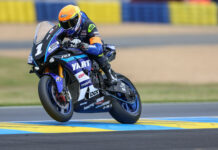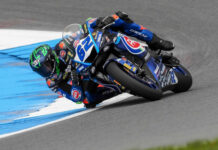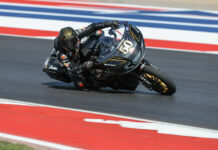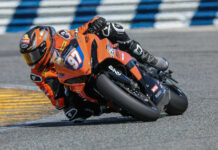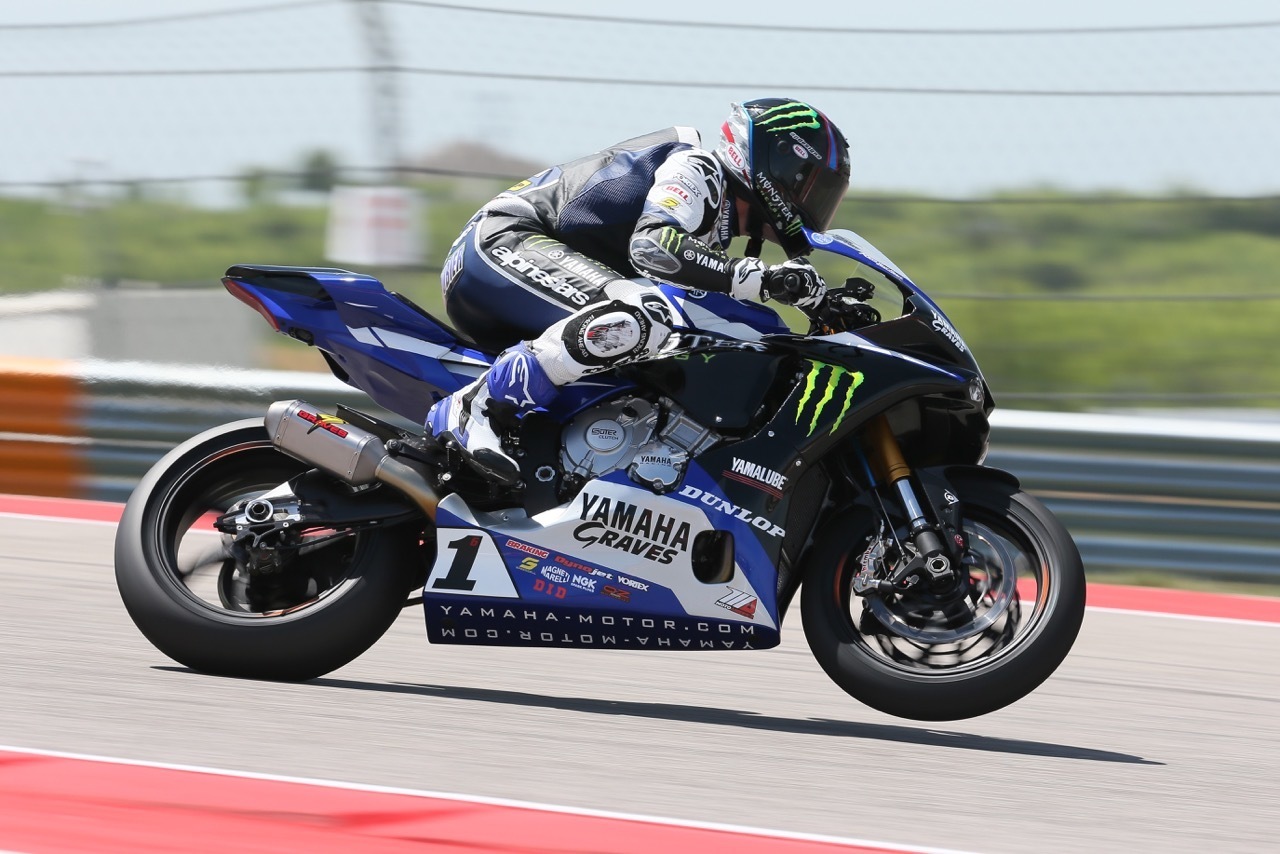MotoAmerica is bringing its Superbike technical rules into closer alignment with FIM Superbike rules for the 2017 season.
The rules governing the premier class of each series were already very close in 2016, but there were some significant differences.
World Superbikes were allowed modifications to the frame to allow adjustments to the position of the steering stem and swingarm pivot, replacement of the forks and swingarms with approved aftermarket units, and the use of either stock internal transmission gear ratios or one optional set of gear ratios. At the same time, the World Championship limited riders to the use of only one motorcycle (until it became damaged beyond repair) at each event and just seven engines during the entire race season.
In 2016, MotoAmerica Superbike tuners could not modify frames beyond adding gussets and bracing, could only use the stock transmission gear ratios, and had to use stock fork externals and stock swingarms, but riders were allowed to alternate between two motorcycles during practice and qualifying at each event and there was no limit on the number of engines that could be used during the season.
For 2017, MotoAmerica Superbike tuners will now be allowed to modify frames to move the steering stem and swingarm pivot locations (within a prescribed range) and to replace the forks and swingarms with approved aftermarket units. But the stock internal gear ratios must be used. A limit to the number of engines that can be used during the season is still being discussed, but a one-bike rule will be in place during the 2017 MotoAmerica Superbike season (as it was for the MotoAmerica Superstock 1000 class in 2016).
One other significant change: The special American Superbike Kit electronics some MotoAmerica teams had been using since 2014 will no longer be allowed in 2017. These teams will be forced to upgrade to new electronic systems that comply with the World Superbike and Superstock 1000 FIM Cup rules and price cap.
The 2017 MotoAmerica Superstock 1000 class rules, meanwhile, will be much different than the 2017 rules for Superstock 1000 FIM Cup. The MotoAmerica Superstock 1000 rules already differed from FIM Superstock 1000 rules in 2016 primarily because MotoAmerica Superbike and Superstock 1000 raced over the same distance while on the track at the same time. This led to MotoAmerica Superstock 1000 bikes being allowed to run enlarged stock fuel tanks. MotoAmerica Superstock 1000 racebikes are also allowed to use Superbike-spec aftermarket brake calipers, discs, pads and master cylinders. FIM Superstock 1000 machines use stock fuel tanks for their shorter races and tuners are only allowed to change front discs and brake pads.
In 2017, MotoAmerica Superstock 1000 frames will be allowed to have modifications in order to move the swingarm pivot position. Stock swingarms must be used but can be braced and modified to increase the range of axle adjustment, and changes to the steering stem angle using inserts within the stock steering head will be allowed; and aftermarket triple clamps and rear suspension linkages will be legal. Superstock 1000 racebikes will also be allowed to use custom fuel tanks that fit within the 2016 MotoAmerica Superbike rules.
Technical rules governing the Supersport and Superstock 600 classes will remain unchanged for the 2017 season.
“From the outset our plan has been to move our Superbike rules to match those used by the World Superbike Championship,” MotoAmerica/KRAVE Group partner Chuck Aksland said. “With a few minimal differences, we’ve actually been able to accomplish this quicker than we thought. The rules have proven to work well in the World Championship so moving toward those as quickly as possible was important to us for our growth as a domestic Superbike Championship. The alignment with the World Superbike Championship provides an easier route for manufacturers to participate in the MotoAmerica Series. Development resources can now be shared across multiple championships. The same parts developed for the World Championship can now be used here in MotoAmerica and vice versa.
“In addition, the changes we’ve made to the Superstock 1000 rules were made to give those teams and riders the freedom to make some changes that will help them get closer to the Superbikes, performance-wise with minimal cost. Ultimately the goal is to separate the two championships, but until that time comes we’d like the field to be as competitive as possible. We’ve seen a few times this year that the Superstock 1000 machines were not that far away. With a few more modifications, we hope to see the gap close up a bit on track to the Superbikes.”
MotoAmerica factory team managers contacted by Roadracing World seemed to be receptive to the changes to the 2017 Superbike and Superstock 1000 technical rules–even though they will increase costs for teams looking to be competitive.
“Honestly, I think it’s moving in the right direction,” said Keith McCarty, Yamaha Motorsports Racing Division Manager. “I’m not sure if the timing was perfect, but certainly the direction is something that appears might be necessary to get everybody [manufacturers] back playing in road racing again. And for that, we’re OK. Timing-wise, I guess we’ll find out how much impact it will have on bringing the people back into Superbike racing. All in all, I like the direction, I like the thought process of MotoAmerica, but timing is everything in the world. So only time will tell.”
“We’re ecstatic about it,” said Rich Doan, Team Manager for Yoshimura Suzuki. “We are thrilled to get back to racing Superbikes. We’ve still been racing Superbikes in a sense, but some of the ‘Super’ had been taken out of the Superbikes. Let’s get back on par with World Superbike. Let’s not be a step below them. I’m thinking of the tech fans who like to see parts on the bikes that they can’t afford or can’t get, it should bring a lot of people back.”
Doan added that the communication between the teams and MotoAmerica during the lead-up to the rule changes was “Very professionally done. It was a very professional dialogue. It wasn’t ‘This is what we’re doing. Take it or leave it.’ It did go back and forth. And what I’m pleased about, like MotoAmerica said two years ago, we’re going toward World Superbike rules, and they’ve kept that vision. The whole paddock might not be ready to take that step, but that’s where we’re going. As far as the future of Superbike racing here in the States and getting more manufacturers [involved] and possible outside-of-the-industry sponsorship it’s the best possibility for that since 2008. It’s all headed in a very good direction.”
For a view from the perspective of a team running in the MotoAmerica Superstock 1000 class, we contacted Ameen Sajjadi, owner of the Wheels In Motion/Meen Motorsports Yamaha team that won the 2016 Superstock 1000 Championship with Josh Herrin.
“Adding a few geometry changes to help certain bikes have more of an advantage or level the playing field, I think it’s a good thing,” for Superstock 1000, said Sajjadi. “It’s a very minimal cost to Superstock 1000. It’s really not that much to add triple clamps and a [shock] link and [make] minimal modifications to the swingarms, like changing the [axle adjustment] blocks in the back.
“That’s all stuff that if we would have been able to change that this year we would have been able to keep up with the Superbikes at certain races, like VIR and Alabama and New Jersey. It might keep the field a little bit closer. For Superstock 1000, it’s an OK direction. I think what they’re trying to do is help everyone transition eventually into one [Superbike] class by slowly adding parts to Superstock 1000.”
“I think that this is what they wanted to do from the beginning, align everything with the World Championship,” said Kyle Wyman, rider/team owner of the Millennium Technologies/Kyle Wyman Racing Yamaha Superbike. “I think the timing is right for that, from a series perspective, for everybody. For me personally, the more stock the better because of where I’m at with my program. I don’t have the budget to go do that [take full advantage of the new Superbike rules]. Even if I did, the things that come along with going to [aftermarket] forks and swingarms and stuff like that it’s not just the cost of the parts themselves but it’s the cost of going testing and validating those parts and making sure that you’re actually going forward by adding them. I think that’s something that’s kind of missed when talking about cost and stuff like that.
“For me, I think it’s the right move for our series. I don’t know that it helps me personally at this point. We’ll see where I end up. I think there’s a chance that I may go down into Superstock 1000 just because now my bike is even closer to Superstock-spec than it ever was to Superbike. At this point all I have to do is take my [aftermarket] wheels off and I’m Superstock-legal.”
“I have mixed feeling,” said Keith Perry, Crew Chief and General Manager of Team Hammer, which raced as M4 SportbikeTrackGear.com in Superbike, Superstock 1000, Supersport and Superstock 600 in 2016. “I understand what they’re trying to do, get closer to World Superbike rules. I understand the reasoning behind most of this stuff. But one of the things I’m concerned about is raising the corner speeds of the big bikes more than they already are. All of our tracks are pretty safe, but there’s not a lot of room for error when it comes to some tracks. And I’m afraid that big forks and swingarms on Superbikes and triple clamps and links on Superstock 1000s is going to increase the overall speed of both classes, and the corner speed will go up significantly. I don’t know how much they thought about that. Maybe it will be fine. I hope it is. But that’s one thing I think we’re pushing the envelope and causing some tracks to be less safe than they were before because the corner speeds are going to be higher.”
As for MotoAmerica’s decision not to change any of the rules governing Supersport and Superstock 600, Perry said, “I am happy with the 600cc rules. I see no reason to alter the 600 rules right now. They appear to be working. I’d just like to see more participation in Supersport.”


